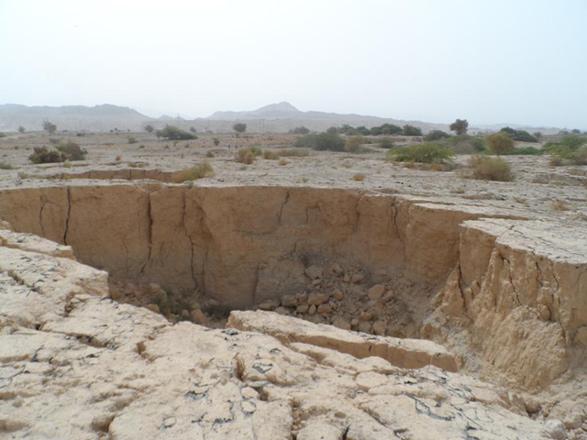By Saeb Rawashdeh – Nov 12,2020
A sinkhole near the Dead Sea (Photo courtesy of Nizar Abu-Jaber)
AMMAN — Is the Dead Sea going to be really dead? According to a Jordanian geologist, the water levels of the Dead Sea are decreasing between one and one metre- and-a-half annually.
“The current level of the Dead Sea is about 430 metres below the main sea level. In the early 1980s it was about 400 metres below sea level,” said Professor Nizar Abu-Jaber from the German- Jordanian University in an interview with The Jordan Times.
In other words, this means that the area of the Dead Sea is smaller as well, he continued, adding that under normal circumstances that would mean that drop would slow down because less surface area is exposed to evaporation.
“Unfortunately, potash extraction requires the evaporation of the Dead Sea water, which means that the evaporation rate has not slowed down,” the professor said.
Unlike some experts who blame climate change for the drop of the Dead Sea levels, Abu-Jaber has different explanations. The diversion of headwaters of the Jordan River and other resources causes evaporation to exceed replenishment.
While about 2000 million cubic metres of water evaporate from the Dead Sea every year, currently less than 300 million cubic meters flow into it from the Jordan River and other smaller rivers, he said.
With regard to environmental challenges, the geologist continued, these include increased seepage of fresh groundwater into the Dead Sea. More importantly, these changes are a threat to the livelihoods and infrastructure invested in the area as sinkholes in Ghor Haditha in the south threaten farmers and their lands, as they suddenly appear and swallow up large areas overnight, he said.
One of the problems is the accommodation of hotels on the Dead Sea shores to an increasing distance between them and the sea.
“Dropping sea levels also means dropping the base level,” Abu-Jaber stressed, noting that rivers tend to continue cutting down their channels towards the lowest point of the river at its terminus (the base level). Because the base level is dropping, the rivers that go into the Dead Sea are adjusting their channels to the new base level.
This is causing the undercutting of the bridge foundations and threatening them with collapse, and the highway is also threatened in some places for the same reason, Abu-Jaber said.
To prevent the shrinking of the Dead Sea, Jordan has been planning to channel water from the Red Sea to the Dead Sea. However, that move, if not carefully observed could lead to an environmental catastrophe, experts warned, according to the professor.
“If we are to protect the tourism, farming, potash extraction and infrastructure in place, something needs to be done to halt the alarming drops in water level,” Abu-Jaber said, noting that it will not be possible to go back to the natural state and allow for the fresh tributary water to replenish the Dead Sea.
“It will also not be possible [or ultimately too helpful] to stop potash production. This means that a project like the Dead-Red canal is the only option to maintain the level of the Dead Sea and to be able to continue to use it and enjoy it,” Abu-Jaber said.
